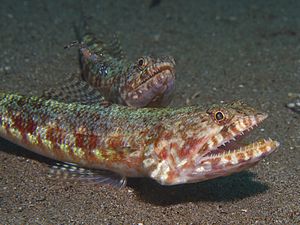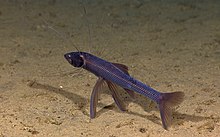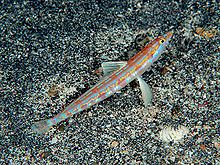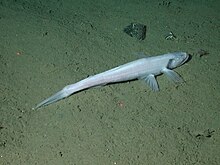Lizardfish
| Lizardfish | ||||||||||||
|---|---|---|---|---|---|---|---|---|---|---|---|---|

|
||||||||||||
| Systematics | ||||||||||||
|
||||||||||||
| Scientific name | ||||||||||||
| Aulopiformes | ||||||||||||
| Rosen , 1973 |
The lizardfish-like (Aulopiformes) are an order of mostly small, predatory real bony fish (Teleostei). They live near the ground in the sea and in brackish water , but most of them live in the deep sea.
features
Lizardfish are always more or less elongated fish with a large mouth and forked caudal fin . They reach body lengths between 1.6 cm ( Lestidiops pacificus ) and 2.15 meters ( Alepisaurus ferox ). In most cases there is an adipose fin . All lizardfish species lack the swim bladder . Special gill pots, which distinguish the lizard fish-like from all other real bony fish , are a derived characteristic . The second pharyngobranchial, the uppermost bone of the second branchial arch, is clearly elongated posteriolaterally and points away from the third pharyngobranchial. The second epibranchial, the second bone from the top of the second branchial arch, is connected to the second pharyngobranchial and has a long, hook-like, curved process. Maxillaries and supratemporals (a skull bone) are dentate. Ural and rearmost praural vertebral bodies (vertebrae of the caudal spine) are not fused together.
Way of life
All lizardfish species are marine animals, most species live in the deep sea. The species of the families flag fins (Aulopidae), green eyes (Chlorophthalmidae), reticulated eye fish (Ipnopidae) and lizard fish (Synodontidae) are ground dwellers, all others are pelagic or bathypelagic . Most lizardfish species are hermaphrodites , meaning that they have functional female and male gonads .
External system
The lizard- fish-like are the sister group of the Ctenosquamata , a high taxon (a systematic group) of the real bony fish , to which the lantern- fish-like (Myctophiformes) and the Acanthomorpha (the spiked bony fish) belong. The following cladogram shows the systematic position of the lizardfish species:
| Neoteleostei |
|
||||||||||||||||||
|
|
Internal system
The systematics of the lizard fish species presented below is based on morphological data and DNA analyzes and also includes extinct taxa.

- Subordination Ichthyotringoidei †
- Subordination Halecoidei †
- Subordination aulopoidei
- Lizardfish (Synodontidae)
- Flagfins (Aulopidae)
- Pseudotrichonotidae
- Subordination Paraulopoidei
- Subordination to Alepisauroidei
- Superfamily Ipnopoidea
- Reticulated eye fish (Ipnopidae)
- Telescopic fish (Giganturidae)
- Bathysauroididae
- Deep sea lizardfish (Bathysauridae)
- Superfamily Chlorophthalmoidea
- Green eyes (Chlorophthalmidae)
- Superfamily Notosudoidea
- Superfamily Alepisauroidea
- Pearl eyes (Scopelarchidae)
- Saber toothfish (Evermannellidae)
- Sudidae ( Sudis )
- Barracudinas (Paralepididae)
- Cimolichthyidae †
- Enchodontidae †
- Alepisauridae
- Lestidiidae
- Superfamily Ipnopoidea
The following cladogram shows the family relationships according to Davis:
| Lizardfish relatives |
|
||||||||||||||||||||||||||||||||||||||||||||||||||||||||||||||||||||||||||||||||||||||||||||||||
|
|
Fossil record

In contrast to numerous other bony fish orders, the lizard fish species have a rich fossil record. Numerous forms are known, especially from the Upper Cretaceous of Lebanon , which are often not as elongated as recent lizard-fish-like, but more like a herring or salmon-like shape. These taxa were often placed in their own suborder, the Enchodontoidei, which, however, is not a monophylum .
literature
- Joseph S. Nelson , Terry C. Grande, Mark VH Wilson: Fishes of the World. Wiley, Hoboken, New Jersey, 2016, ISBN 978-1118342336 .
- EO Wiley & G. David Johnson: A teleost classification based on monophyletic groups. in Joseph S. Nelson, Hans-Peter Schultze & Mark VH Wilson: Origin and Phylogenetic Interrelationships of Teleosts. 2010, Verlag Dr. Friedrich Pfeil, Munich, ISBN 978-3-89937-107-9 .
Individual evidence
- ↑ Lestidiops pacificus on Fishbase.org (English)
- ↑ Alepisaurus ferox on Fishbase.org (English)
- ^ Robert L. Carroll: Paläontologie und Evolution der Vertbeltiere , Thieme, Stuttgart (1993), page 132, ISBN 3-13774-401-6
- ^ A b Matthew P. Davis: Evolutionary relationships of the Aulopiformes (Euteleostei: Cyclosquamata): a molecular and total evidence approach. in JS Nelson, H.-P. Schultze & MVH Wilson (Eds.): Origin and Phylogenetic Interrelationships of Teleosts. Publishing house Dr. Friedrich Pfeil, Munich, Germany - ISBN 978-3-89937-107-9
- ^ Nelson (2016), pp. 266-276.
- ^ Karl Albert Frickhinger: Fossil Atlas Fish , Mergus-Verlag, Melle, 1999, pages 630-653, ISBN 3-88244-018-X
- ↑ Hilda MA Silva; Valéria Gallo: Taxonomic review and phylogenetic analysis of Enchodontoidei (Teleostei: Aulopiformes). Anais da Academia Brasileira de Ciências ISSN 0001-3765 doi : 10.1590 / S0001-37652011000200010
Web links
- Lizardfish on Fishbase.org (English)






